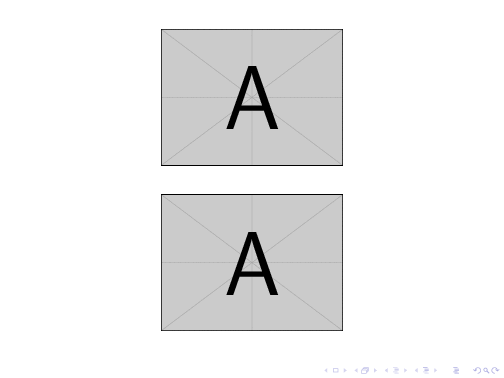I understand that by using overlays in a beamer presentation, one is able to lock text within a frame, and continue to display other items without affecting the position of the previous item(s) being displayed. What I want to do, however, is to replace one particular overlay with another, without affecting the position of the previous overlays that are being displayed. I am not quite sure how to do this. The best that I have been able to come up with is in the following sample of code, where I am trying to preserve the position of the definition and the matrix in separate slides.
\documentclass[11pt,xcolor=pdftex,dvipsnames,table]{beamer}
\usepackage{multirow}
\usepackage{beamerthemesplit}
\usetheme{Berkeley}
\usecolortheme{dolphin}
\usepackage{graphicx}
\usepackage{epsf}
\usepackage{pgfplots}
\pgfplotsset{compat=newest}
\title[Short Title]{Longer Presentation Title}
\author[John Doe]{John Doe}
\institute{University of Nowhere}
\date{July 7, 2011}
\begin{document}
\maketitle
\begin{frame}
\frametitle{Introduction}
\setbeamercovered{dynamic}
\framesubtitle{Definitions (Cont...)}
\textit{Definition 5:} If $A$ is an $m \times n$ matrix, $I$ is a subset of $\{1, ..., m\}$ with $k$ elements, and $J$ is a subset of $\{1, ..., n\}$ with $k$ elements, then the matrix for the $k \times k$ minor of $A$ that corresponds to the rows with index in $I$ and the columns with index in $J$, is written as $[A]_{I,J}$. \pause
\newline
\newline
If $I = J$, then $[A]_{I,J}$ is called a \textit{principal minor}.
\newline
\newline
\[A =
\left(
\begin{array}{rrr}
\multicolumn{1}{r}{1} & \multicolumn{1}{r}{4} & \multicolumn{1}{r}{7} \\
\cline{2-3}
\multicolumn{1}{r}{3} & \multicolumn{1}{|r}{0} & \multicolumn{1}{r|}{5} \\
\multicolumn{1}{r}{-1} & \multicolumn{1}{|r}{9} & \multicolumn{1}{r|}{11} \\
\cline{2-3}
\end{array}
\right), \mbox{~where~} I = \{2, 3\} \mbox{~and~} J = \{2,3\}
\]
\end{frame}
\begin{frame}
\frametitle{Introduction}
\setbeamercovered{dynamic}
\framesubtitle{Definitions (Cont...)}
\textit{Definition 5:} If $A$ is an $m \times n$ matrix, $I$ is a subset of $\{1, ..., m\}$ with $k$ elements, and $J$ is a subset of $\{1, ..., n\}$ with $k$ elements, then the matrix for the $k \times k$ minor of $A$ that corresponds to the rows with index in $I$ and the columns with index in $J$, is written as $[A]_{I,J}$.
\newline
\newline
If the matrix consists of elements in rows and columns from $1$ to $k$, then the principal minor is called a \textit{leading principal minor}.
\[A =
\left(
\begin{array}{rrr}
\cline{1-2}
\multicolumn{1}{|r}{1} & \multicolumn{1}{r|}{4} & \multicolumn{1}{r}{7} \\
\multicolumn{1}{|r}{3} & \multicolumn{1}{r|}{0} & \multicolumn{1}{r}{5} \\
\cline{1-2}
\multicolumn{1}{r}{-1} & \multicolumn{1}{r}{9} & \multicolumn{1}{r}{11} \\
\end{array}
\right), \mbox{~where~} I = \{1,2\} \mbox{~and~} J = \{1,2\}
\]
\end{frame}
\end{document}
Any help/suggestions on how I can do this would be appreciated.


Best Answer
You could use
overlayarea(see Section 9.5 Dynamically Changing Text or Images of the manual),\onslide, and\only: